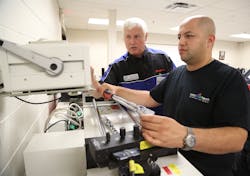Public-Private Partnerships Help Make Careers in Aviation Maintenance Stronger Than Ever
Being an aircraft maintainer is a highly skilled profession that offers career advancements, job security, and good working conditions … not to mention a tremendous amount of responsibility and respect. So why aren’t more young people considering a career in aviation maintenance?
This is a question that the industry has been asking for a while. Many observers believe a glut of job openings is on the horizon as companies look to hire replacements for the baby-boomer technicians expected to retire in the near future. This issue was in the spotlight recently thanks to Boeing’s 2015 projections that 609,000 technicians will be needed to maintain the large number of new and existing airliners expected to be in service globally in the next 20 years.
So what can be done to help turn the tide and raise awareness about careers in aviation maintenance? One answer is unique public-private partnerships between companies and technical schools and community colleges to help train the next generation of professionals.
Is There Really a Shortage Looming?
Some observers claim that there really isn’t a shortage of aviation technicians. They argue that some airlines and MROs are lowering wages to save money, driving qualified people out of the hangars and into other industries. Conversely, some say just the opposite, that companies are worried there may not be enough students in the training pipeline to fill anticipated job vacancies in the coming years.
Depending on who you talk to, both arguments seem to merit further discussion. However, a 2014 study headed up by The College of William & Mary on the issue believes employers may very well have difficulty finding enough qualified candidates to fill aviation maintenance-related job openings in the next few years.
The study, Policy Solutions for a Stronger Technical Workforce, cites the rate of FAA certification for maintenance personnel as declining from 2008 to 2013. It points to two possible reasons for this drop. First, it points out that baby-boomer technicians are retiring, and schools are not producing enough qualified students to replace them at an equal rate. Also, some graduates are taking their skills and training, much of which is transferable to other industries, and leaving for industries that offer better pay and career opportunities.
The looming shortage of aviation technicians has also gotten the attention of the American Association of Community Colleges. Seven hundred AACC members attended a recent conference in New Orleans, where I presented an industry viewpoint on the training of future AMTs at a lively breakout session.
While the level of compensation can be subjective from one person to the next, it’s pretty clear that for those technicians who are trained and certified, and looking to stay in aviation, the need for their skills will continue to be in demand now and in the future.
Public-Private Partnerships
Many technicians in a variety of industries begin their studies at technical schools or community colleges. There are several schools in the United States that offer aviation maintenance-focused degrees, and they do a great job providing a valuable service in training the technicians of tomorrow.
But schools don’t have to do it alone. Many institutions are partnering with the industries they serve to advance their programs, coming together with a single purpose – to more effectively prepare students for success.
Companies like Snap-on have become pioneers in this area by creating a collaborative program with technical schools and community colleges to train and certify students on the proper use of tools and equipment for the aviation industry. The certifications provide conformity and an across-the-board standard for the partnering colleges and schools to teach in-depth instruction on tool use, theory, and application.
These types of partnerships can be an attractive recruiting tool for both schools and students alike. From the schools’ perspective, it gives them the opportunity to broaden their program by leveraging the market knowledge and insights that private industry can bring to their academic disciplines. Working together, schools can tailor their curriculum to the real-world needs of the aviation industry – which better prepares students for success when they enter the workforce.
And this is the primary benefit to students. When students apply for a job, they not only have their A&P certificate or degree, but also certifications on the tools and equipment that they’re expected to know how to use on day one, making them a much more attractive candidate for the position than someone who doesn’t have those credentials on their resume.
Applicable aviation-focused certifications include electrical measurement (multi-meter) and torque (mechanical and electronic), both of which are being offered at Part 147 aircraft maintenance schools. The instructions for these certifications are integrated into the school’s aviation maintenance courses of study. Schools such as Wichita Area Technical College in Wichita, KS; Pima Community College in Tucson, AZ; Teterboro School of Aeronautics in Teterboro, NJ; and Wayne Community College in Goldsboro, NC, are just some of the schools partnering with Snap-on and offering certifications.
As specific Snap-on disciplines are taught throughout a student’s career at the college, they are tested on the material. Students who pass receive certification on that discipline – making them more productive and well-rounded professionals.
To help facilitate these certifications, Snap-on has partnered with the National Coalition of Certification Centers, a network of education providers and corporations that support and validate new and emerging technology skills within several transportation and industrial markets.
The goal of Snap-on’s involvement in technical education is not only to help train future technicians, but to support the aviation industry as a whole. This is done by working with airlines, manufacturers, and MROs to develop tools and equipment specific to aviation, as well as knowledge sharing, sponsorships, and other outreach efforts.
Aerospace Maintenance Competition
The Aerospace Maintenance Competition presented by Snap-on is a good example of private industry collaboration that helps promote and celebrate the aviation maintenance profession. The Aerospace Maintenance Competition is a one-of-a-kind event that honors the skills and functions performed by certified aircraft technicians around the world. This year’s competition is April 5-7 at the MRO Americas Convention in Dallas.
The competition is also open to students enrolled in FAA, EASA, CASA, or equivalently authorized schools, military aircraft maintainers, and spacecraft maintenance personnel. Teams test their skills against one another by completing more than 20 tasks in the shortest amount of time. Last year more than 40 teams representing seven countries participated in the event.
The two-day competition showcases the critical skills that are needed by today’s technicians to keep aircraft and air travel safe. The event is also a great networking opportunity for students, serving as a recruiting tool for colleges and the industry. Many schools conduct year-long training on the events, and select the best-of-the best to represent them at the competition.
Gary Driscoll, a team leader from Salt Lake Community College, which took 11 students to the 2015 competition in Miami, says events like this offer an invaluable experience for aspiring technicians. “It helps us refine our skills, particularly the teamwork aspect of performing our jobs,” Driscoll says. “Our students learned how to function in a group to get a task done. In this industry you can’t do certain job functions on your own, you have to work as at team. They learned that at the event. Also, the ability to compete right along some of the best in the industry – what a great experience for our students.”
“Being able to network is very important and was one of the main reasons I wanted to come and meet people in the industry,” says Jennifer Lesher, a student at South Seattle College and participant in last year’s event. “We have Alaska Airlines and Boeing in our hometown, but we don’t have the entire world of aviation maintenance assembled in one place like we do here. It’s awesome to be able to see everyone at one time and talk to people about the profession, people who I might be working with in the future.”
The Time is Now
If there was ever a time to consider a career in aviation maintenance, this is that time. The industry is strong and vibrant, and showing signs of growth. John Goglia, an independent aviation consultant and former airline mechanic for more than 30 years, said in a 2014 Forbes column that he predicts, “… that these shortages combined with increased airline profits will begin to be reflected in the pilot and mechanic pay and benefits. Young people with a passion for aviation can look to that field for their careers.”
Hundreds of thousands of technicians are forecasted to be needed in the coming years, but those personnel need to be trained, certified, and ready to fill those openings. Academia, public-private partnerships, and the industry are coming together to support those who choose to pursue this challenging, yet rewarding career. Grab your tools … the profession is waiting for you.
Scott Steward is the business development manager at Snap-on Industrial. He can be reached at (561) 212-6404 or [email protected].
About the Author

Scott Steward
Business Development Manager
Scott Steward is the business development manager at Snap-on Industrial. He can be reached at 561-212-6404; [email protected].
